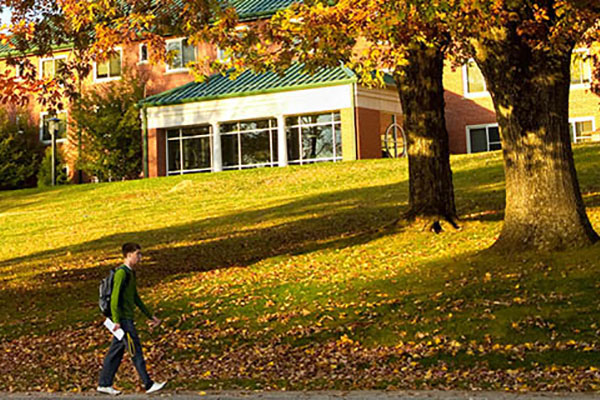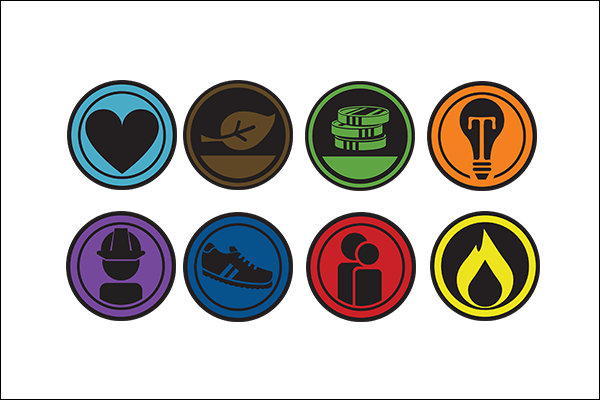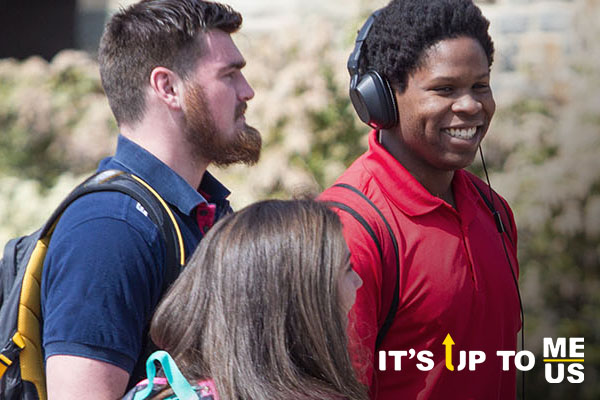By Linda Coutant | April 24, 2020
Appalachian State University wants its students to stay in good health and well-being, throughout the year and especially during exams.
In this video recorded in fall 2019, Torre Hinnant, M.D., in Appalachian’s M.S. Shook Student Health Service demonstrates a series of meditation skills — breathing techniques, simple movement and other mindfulness activities — to help keep your stress at a healthy level.
Hinnant also introduces viewers to the Rich Mountain Meditation Room in Plemmons Student Union, a walk-in space that students are encouraged to use as a quiet reprieve from their busy lives, and for prayer and meditation or small group spiritual gatherings.
Transcript
Dr. Torre Hinnant: Hi, I’m Dr. Hinnant and I’m a board certified family medical doctor, and I’m a staff physician at Student Health at Appalachian State University. We’re here today at the student union on the third floor at the Rich Mountain Meditation Room that you have access to any day. All you do is come up here and sign up and you can use this space for anything. So, you can sign up for this space day of for meditation or quiet reflection. Today I’m going to be teaching you some mindfulness techniques and some stress management techniques to help you survive the exam period this year.
I’m going to start off here by saying something pretty radical. Stress isn’t bad. Stress can actually, in some situations, be really great. It can make you perform at a really high level. It can motivate you to study more. It can motivate you to run that next mile. It can be a wonderful thing and we all need stress in our lives. We do.
But it’s when stress reaches too high of a point where it becomes counterproductive, or if we don’t give our bodies time to rest and recover in between times of performing at a high level that we could get sick or that we won’t be able to study as well, or focus as well, or perform as well on the tests that we’re studying for. So, I’m going to be teaching you some stress management tools that are going to help you manage your stress and keep it at a more neutral level.
One of the techniques is breathing; because the breath, by increasing our breathing, the length of our inhalation and the length of our exhalation, sends a message to the brain and then it activates the vagus nerve that is connected to many of the functions of the parasympathetic nervous system. Now that may have all sounded like Greek to you, and that’s OK if it did. Pretty much it’s going to, by taking deep breaths, help you to relax. That’s the bottom line.
So the first breathing technique that I’m going to teach you is the seven, seven, seven breath. It’s seven count on the inhalation. You hold the breath for seven, but not holding it like in your body with your shoulders all the way up to your ears, but with relaxing your shoulders away from your ears. You hold the breath for seven, and then you exhale for seven. And you’re usually inhaling and exhaling through your nose.
So, you’re sitting here now, nobody would know that you’re doing it. Sitting here in the waiting room, you can try it. So we’ll inhale: seven, six, five, four, three, two, one. Hold without tensing: seven, six, five, four, three, two, one. Then exhale: seven, six, five, four, three, two, one. Try it again. Inhale: five, six, seven. Hold: seven, five, three, one. Exhale: seven, five, three, one. And then just sit here and notice for a minute how that makes you feel. Perhaps after only a couple of deep breaths you feel better, you feel more relaxed.
Now, this can be a really great tool when you’re going into an exam and you’re feeling that jitteriness or if you have to give a presentation, or if you’re just feeling overly stressed, it can help calm you down. Our bodies are made to work at a really high level and then to rest and recover. Olympic athletes know this, so we need to know this. So this breath and the next one that I’m about to teach you helps you move into that recovery state where the parasympathetic nervous system, that resting part of your nervous system, can calm you down and then you’ll feel more focused and able to do what you need to do next.
The next technique I’m going to teach you is called belly breathing. And it’s a funny name because of course we don’t actually breathe into our belly. We breathe into our chest and our rib cage area, that’s where our anatomic lungs are. But the diaphragm that is in between the lungs and the abdomen, the belly, goes down when you inhale and then the lungs pull air in and then it goes up on the exhalation and breath goes out. So when the diaphragm goes down, if the belly is relaxed, it’ll move out slightly away from the body, away from the spine. And then as you exhale, it will move in slightly towards the spine.
So we’re going to make that bigger in this breath. So just sit there relaxed and take in a deep breath, and if it helps to put your hand on your belly you can, and kind of push your navel, your belly, against your hand, pushing it away from your spine on the inhalation. And then on the exhalation, hold the navel back towards your spine. And we’re making it longer and slower, the breath. So you’re inhaling: four, three, two, one as you push it out. And then in exhaling: four, three, two, one as you pull the navel back towards the spine. So try that a couple more times. Inhaling: four, three, two, one. And then exhaling: four, three, two, one.
And then just take a moment to breathe normally and naturally, whatever that is, and just notice how that makes you feel. It can help calm you down almost immediately. I’ve done this when sitting in standstill traffic on King Street, and I start to get upset because I have somewhere to be five minutes ago. I’ll start doing belly breathing. So it’s really good for emotional balance, for concentration and to just kind of bring you back to a more neutral, calm state where you can focus more effectively.
Another important thing to think about are our eyes while we are studying and using computers a lot. Perhaps during exam time you’re going to have to sit in front of a computer for hours on end. I’d like to encourage you, every hour, to give your eyes a break and look away from the computer and focus on something perhaps outside the window like a tree or in the distance so that you get your eyes to relax as they focus further away. And then after a minute just you can bring your eyes back to the computer.
Or another thing you can do to help prevent eyestrain is you can rub your hands together until you feel heat in between your hands. It’s hard to do with glasses on, but you then rest your palms over your eyes, fingertips at the hairline; and you get a little bit of darkness, a little bit of warmth and it helps relieve eyestrain. And then you can get back to whatever work you’re doing on your computer.
So, we also want to pay attention to our body. We spend a lot of time, I know I even do, I have to consciously pull my shoulders back and pull my ears over my shoulders because I’ll start to get neck strain or shoulder pain. I know it happens to almost everybody, especially people who have to be on the computer a lot, which is pretty much everybody these days. So you can do some head rolls, just rolling your head in one direction and the other.
You can do some shoulder rolls, and I would recommend doing a break and doing some head rolls and shoulder rolls and a couple of body stretches about every hour, because a lot of the muscles, like the pectoralis muscles in the front of the chest, they start to get shortened and weak. So we want to stretch them. The trapezius muscle can start to get tense also, and that’s where stretching and rotating the shoulders and the neck can really help relieve any kind of neck and shoulder strain that can happen with studying or writing papers for long hours.
Also we can do spinal extensions, and in yoga we have the cat and the cow and I’ll show it to you. You can even do it in a chair. So you can just turn to the side and in the cat … well, you sit on the edge of your chair and for the cat, you arch your spine down like this. And then for the cow, you sway your back and gaze up. And then you can connect this with your breath. So you can exhale through your nose, curving the spine, inhale through the nose, stretching the spine, and this really helps relieve the muscles around the spine also.
Another good thing to do is to do a spinal twist where you cross one leg over. I’m crossing my left leg over, and then taking the opposite arm, my right arm on the outside, and then take my left hand behind me and do a spinal twist, getting a good stretch. And then you can do it the other way too. So, those are some spinal stretches that are really good.
So we’ve talked about resting your eyes, giving them a break every hour, giving your body a break every hour, doing either some sitting stretches or you can stand up and take a big stretch and that’s really good for blood flow, not just to the brain but to the body and also just helps you relax for a moment so that you can then focus better when you sit back down to study or work again.
Another important thing that I’m sure you’ve all heard a lot about is sleep. Sleep is great, and getting enough sleep is so important during this time, during exam time because that’s another way that our body really recovers and repairs while we’re asleep. So, try to decrease caffeine, especially after noon, because if we’re drinking caffeine late into the night, it’s going to make it almost impossible to sleep.
And though at the time it may feel like you’re able to get more information in your brain, if you’re taking an exam or a test on only three or four hours of sleep, you literally just aren’t going to do as well than if you allow yourself to sleep a couple more hours, then you’ll be able to do much better. So try to decrease caffeine if you drink caffeine.
Another tool, we have some here in these little baskets in Student Health and we got them just for you for this week and it’s lemon balm tea. Lemon balm is an herb, it literally has no contraindications, which pretty much means anybody can take it unless you’re allergic to lemon balm. You can drink it during the day if you’re feeling overly anxious, you can also drink it about an hour before you go to bed and it’ll help you sleep more soundly. You make memories better and your body repairs better as you sleep more soundly.
Also it’s important to exercise and to eat regular meals. Our brain needs a steady flow of glucose, of blood sugar. And one of the ways that it does that is by eating breakfast, lunch and dinner, and some snacks in between. So, really basic stuff here, but is so powerful when you’re wanting to do really well in school. Also to stay well, if you haven’t gotten your flu shot yet, we give free flu vaccines here at Student Health, so you can sign up and get your flu shot because you don’t want to get the flu. It’s no fun. So, stay well and be well, and we’re here for you if you need anything.
About Appalachian State University
As the premier public undergraduate institution in the state of North Carolina, Appalachian State University prepares students to lead purposeful lives as global citizens who understand and engage their responsibilities in creating a sustainable future for all. The Appalachian Experience promotes a spirit of inclusion that brings people together in inspiring ways to acquire and create knowledge, to grow holistically, to act with passion and determination, and to embrace diversity and difference. Located in the Blue Ridge Mountains, Appalachian is one of 17 campuses in the University of North Carolina System. Appalachian enrolls more than 19,000 students, has a low student-to-faculty ratio and offers more than 150 undergraduate and graduate majors.


M.S. Shook Health Service
The Mary S. Shook Student Health Service is a primary care ambulatory campus health clinic helping meet the needs of Appalachian State University students. It is fully accredited by Accreditation Association for Ambulatory Health Care.

Counseling and Psychological Services
Counseling and Psychological Services offers an array of services and resources to help students move toward their life goals, as well as information and consultation to parents, faculty, and staff as they support them.

Wellness and Prevention Services
Wellness and Prevention Services serves all students through the promotion of healthy behaviors, risk behavior modification services and advocacy for campus-wide health policies which facilitate student success and holistic well-being.

Appalachian Cares
Your source for wellness, health and safety information, resources and support for the campus community
Wellness, health and safety for students, faculty and staff is a top priority for our campus. Our community welcomes all and takes seriously our individual roles to be concerned and compassionate members of this community. We involve faculty, staff and students in the shared responsibility of ensuring the health of our university community, but no one is expected to have all the answers – indeed no one of us does.
As you navigate the challenges of student life, there are many dedicated people and excellent resources on our campus to help. This is a good place to start.